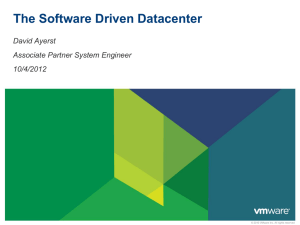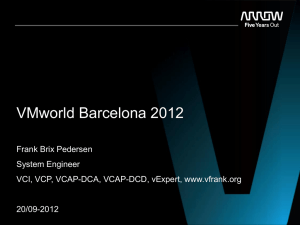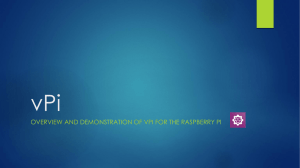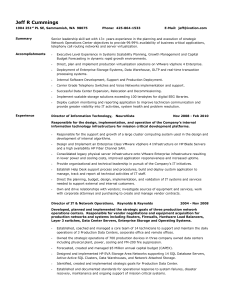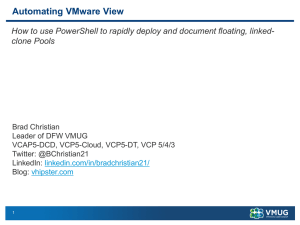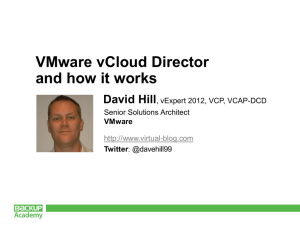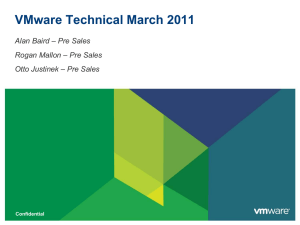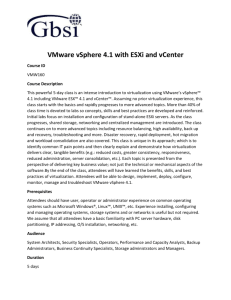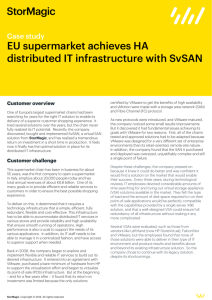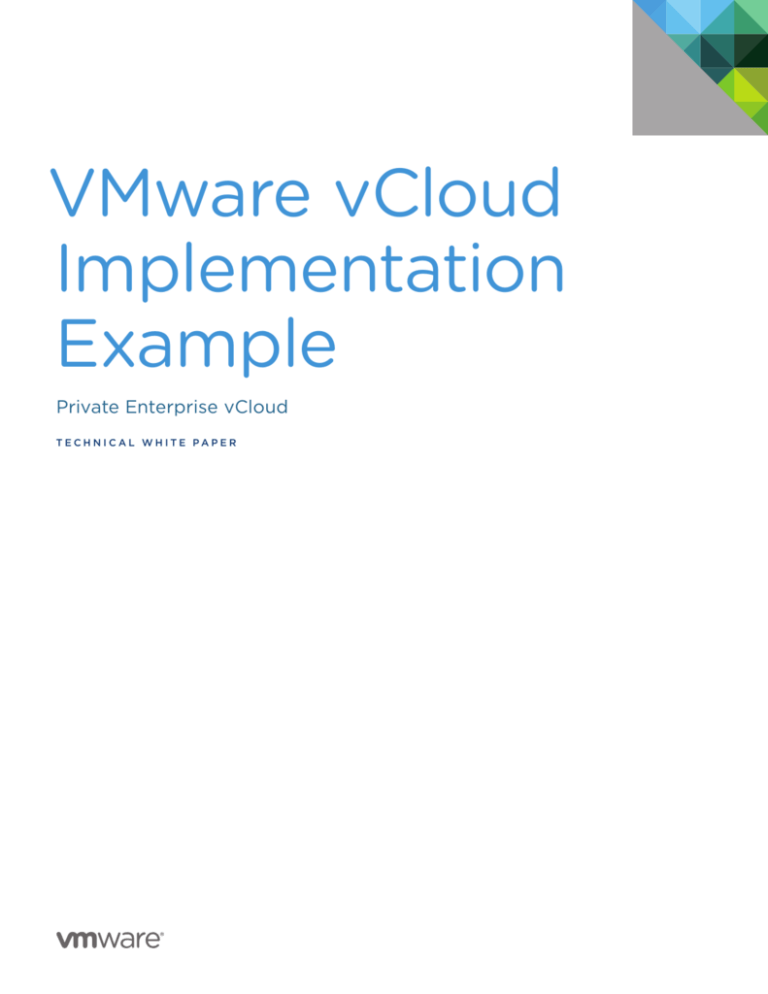
VMware vCloud
Implementation
Example
Private Enterprise vCloud
TEC H N I C A L W H ITE PA P E R
VMware vCloud Implementation Example
Table of Contents
1.Purpose and Overview . . . . . . . . . . . . . . . . . . . . . . . . . . . . . . . . . . . . . . . . . . . . . . . . . . . . . . . 4
1.1 Executive Summary . . . . . . . . . . . . . . . . . . . . . . . . . . . . . . . . . . . . . . . . . . . . . . . . . . . . . . . 4
1.2 Business Requirements . . . . . . . . . . . . . . . . . . . . . . . . . . . . . . . . . . . . . . . . . . . . . . . . . . . . 4
1.3 Use Cases. . . . . . . . . . . . . . . . . . . . . . . . . . . . . . . . . . . . . . . . . . . . . . . . . . . . . . . . . . . . . . . . .4
1.4 Document Purpose and Assumptions . . . . . . . . . . . . . . . . . . . . . . . . . . . . . . . . . . . . . . . 4
2.VMware vCloud Architecture Design Overview. . . . . . . . . . . . . . . . . . . . . . . . . . . . . . . . . . 5
2.1 vCloud Definition . . . . . . . . . . . . . . . . . . . . . . . . . . . . . . . . . . . . . . . . . . . . . . . . . . . . . . . . . . . . 5
2.2 vCloud Component Design Overview . . . . . . . . . . . . . . . . . . . . . . . . . . . . . . . . . . . . . . . 6
3.vSphere Architecture Design Overview. . . . . . . . . . . . . . . . . . . . . . . . . . . . . . . . . . . . . . . . . 6
3.1 High Level Architecture. . . . . . . . . . . . . . . . . . . . . . . . . . . . . . . . . . . . . . . . . . . . . . . . . . . . . . . 6
3.2 Site Considerations. . . . . . . . . . . . . . . . . . . . . . . . . . . . . . . . . . . . . . . . . . . . . . . . . . . . . . . . 8
3.3 Design Specifications. . . . . . . . . . . . . . . . . . . . . . . . . . . . . . . . . . . . . . . . . . . . . . . . . . . . . . 8
4.vSphere Architecture Design – Management Cluster. . . . . . . . . . . . . . . . . . . . . . . . . . 8
4.1 Compute Logical Design. . . . . . . . . . . . . . . . . . . . . . . . . . . . . . . . . . . . . . . . . . . . . . . . . . . 8
4.1.1. Datacenters. . . . . . . . . . . . . . . . . . . . . . . . . . . . . . . . . . . . . . . . . . . . . . . . . . . . . . . . . . 8
4.1.2. vSphere Clusters . . . . . . . . . . . . . . . . . . . . . . . . . . . . . . . . . . . . . . . . . . . . . . . . . . . . . 8
4.1.3. Host Logical Design. . . . . . . . . . . . . . . . . . . . . . . . . . . . . . . . . . . . . . . . . . . . . . . . . . . 9
4.2 Network Logical Design. . . . . . . . . . . . . . . . . . . . . . . . . . . . . . . . . . . . . . . . . . . . . . . . . . . . 9
4.3 Shared Storage Logical Design . . . . . . . . . . . . . . . . . . . . . . . . . . . . . . . . . . . . . . . . . . . . 10
4.4 Management Components . . . . . . . . . . . . . . . . . . . . . . . . . . . . . . . . . . . . . . . . . . . . . . . . 10
4.5 Management Component Resiliency Considerations. . . . . . . . . . . . . . . . . . . . . . . . . 11
5.vSphere Architecture Design – Resource Groups. . . . . . . . . . . . . . . . . . . . . . . . . . . . . . . 12
5.1 Compute Logical Design. . . . . . . . . . . . . . . . . . . . . . . . . . . . . . . . . . . . . . . . . . . . . . . . . . 12
5.1.1. Datacenters. . . . . . . . . . . . . . . . . . . . . . . . . . . . . . . . . . . . . . . . . . . . . . . . . . . . . . . . . 12
5.1.2. vSphere Clusters . . . . . . . . . . . . . . . . . . . . . . . . . . . . . . . . . . . . . . . . . . . . . . . . . . . . 12
5.1.3. Host Logical Design . . . . . . . . . . . . . . . . . . . . . . . . . . . . . . . . . . . . . . . . . . . . . . . . . 13
5.2 Network Logical Design. . . . . . . . . . . . . . . . . . . . . . . . . . . . . . . . . . . . . . . . . . . . . . . . . . . 13
5.3 Shared Storage Logical Design . . . . . . . . . . . . . . . . . . . . . . . . . . . . . . . . . . . . . . . . . . . . 14
5.4 Resource Group Datastore Considerations. . . . . . . . . . . . . . . . . . . . . . . . . . . . . . . . . . 15
5.4.1. Datastore Sizing Estimation . . . . . . . . . . . . . . . . . . . . . . . . . . . . . . . . . . . . . . . . . . 16
6.vCloud Provider Design. . . . . . . . . . . . . . . . . . . . . . . . . . . . . . . . . . . . . . . . . . . . . . . . . . . . . . 16
6.1 Abstractions and VMware vCloud Director Constructs. . . . . . . . . . . . . . . . . . . . . . . 16
6.2 Provider vDCs. . . . . . . . . . . . . . . . . . . . . . . . . . . . . . . . . . . . . . . . . . . . . . . . . . . . . . . . . . . . 17
6.3 Organizations. . . . . . . . . . . . . . . . . . . . . . . . . . . . . . . . . . . . . . . . . . . . . . . . . . . . . . . . . . . . 19
6.4 Networks. . . . . . . . . . . . . . . . . . . . . . . . . . . . . . . . . . . . . . . . . . . . . . . . . . . . . . . . . . . . . . . . 19
TECH N I C AL WH ITE PAPE R / 2
VMware vCloud Implementation Example
6.4.1. External Networks. . . . . . . . . . . . . . . . . . . . . . . . . . . . . . . . . . . . . . . . . . . . . . . . . . . 19
6.4.2. Network Pools . . . . . . . . . . . . . . . . . . . . . . . . . . . . . . . . . . . . . . . . . . . . . . . . . . . . . . 19
6.4.3. Networking Use Cases. . . . . . . . . . . . . . . . . . . . . . . . . . . . . . . . . . . . . . . . . . . . . . . 19
6.5 Catalogs. . . . . . . . . . . . . . . . . . . . . . . . . . . . . . . . . . . . . . . . . . . . . . . . . . . . . . . . . . . . . . . . . 22
7. vCloud Security. . . . . . . . . . . . . . . . . . . . . . . . . . . . . . . . . . . . . . . . . . . . . . . . . . . . . . . . . . . . . 23
7.1 vSphere Security. . . . . . . . . . . . . . . . . . . . . . . . . . . . . . . . . . . . . . . . . . . . . . . . . . . . . . . . . 23
7.1.1. Host Security. . . . . . . . . . . . . . . . . . . . . . . . . . . . . . . . . . . . . . . . . . . . . . . . . . . . . . . . 23
7.1.2. Network Security . . . . . . . . . . . . . . . . . . . . . . . . . . . . . . . . . . . . . . . . . . . . . . . . . . . . 23
7.1.3. vCenter Security. . . . . . . . . . . . . . . . . . . . . . . . . . . . . . . . . . . . . . . . . . . . . . . . . . . . . 23
7.2 VMware vCloud Director Security. . . . . . . . . . . . . . . . . . . . . . . . . . . . . . . . . . . . . . . . . . 23
8.vCloud Management . . . . . . . . . . . . . . . . . . . . . . . . . . . . . . . . . . . . . . . . . . . . . . . . . . . . . . . . 24
8.1 vSphere Host Setup Standardization. . . . . . . . . . . . . . . . . . . . . . . . . . . . . . . . . . . . . . . 24
8.2 VMware vCloud Director Logging. . . . . . . . . . . . . . . . . . . . . . . . . . . . . . . . . . . . . . . . . . 24
8.3 vSphere Host Logging. . . . . . . . . . . . . . . . . . . . . . . . . . . . . . . . . . . . . . . . . . . . . . . . . . . . 24
8.4 VMware vCloud Director Monitoring . . . . . . . . . . . . . . . . . . . . . . . . . . . . . . . . . . . . . . . 25
Appendix A – Bill of Materials. . . . . . . . . . . . . . . . . . . . . . . . . . . . . . . . . . . . . . . . . . . . . . . . . . . 25
TECH N I C AL WH ITE PAPE R / 3
VMware vCloud Implementation Example
1. Purpose and Overview
1.1 Executive Summary
ACME Enterprise will be implementing an “internal next generation datacenter” private cloud built on VMware
technologies.
This document defines the vCloud architecture and provides detailed descriptions and specifications of the
architectural components and relationships for the initial implementation. This design is based on a combination
of VMware best practices and specific business requirements and goals.
1.2 Business Requirements
The vCloud for ACME Enterprise has the following characteristics and provides:
• Compute capacity to support 300 virtual machines, which are predefined workloads.
• Secure multi-tenancy, permitting more than one organization to share compute resources. In a private cloud,
organizations typically represent different departments, and each department may have several
environments such as development or production.
• A self-service portal where Infrastructure as a Service (IaaS) can be consumed from a catalog of predefined
applications (vApp Templates).
• A chargeback mechanism, so resource consumption can be metered and the associated cost provided back to
the appropriate organization or business unit.
Refer to the corresponding Service Definition for further details.
1.3 Use Cases
The target use case for the vCloud includes the following workloads:
• Development and test
• Pre-production
• Demos
• Training
• Tier 2 and Tier 3 applications
1.4 Document Purpose and Assumptions
This vCloud Architecture Design document is intended to serve as a reference for ACME Enterprise architects,
and assumes they have familiarity with VMware products, including VMware vSphere, vCenter, and VMware
vCloud Director.
The vCloud architecture detailed in this document is organized into these sections:
SECTION
DESCRIPTION
vCloud Definition
Inventory of components that comprise the cloud
solution
vSphere – Management
vSphere and vCenter components that support
running workloads
TECH N I C AL WH ITE PAPE R / 4
VMware vCloud Implementation Example
SECTION
DESCRIPTION
vSphere – Resources
Resources for cloud consumption
Design organized by compute, networking,
and shared storage
Detailed through logical and physical design
specifications and considerations
Management and Security
Considerations as they apply to vSphere and VMware
vCloud Director management components
vCloud Logical Design
VMware vCloud Director objects and configuration
Relationship of VMware vCloud Director to vSphere
objects
This document is not intended as a substitute for detailed product documentation. Refer to the installation and
administration guides for the appropriate product as necessary for further information.
2. VMware vCloud Architecture Design Overview
2.1 vCloud Definition
The VMware vCloud is comprised of the following components:
v C LO U D C O M P O N E N T
DESCRIPTION
VMware vCloud Director
Abstracts and coordinates underlying resources
Includes:
• VMware vCloud Director Server (1 or more
instances, each installed on a Linux VM and referred
to as a “cell”)
• VMware vCloud Director Database (1 instance per
clustered set of VMware vCloud Director cells)
• vSphere compute, network and storage resources
VMware vSphere
Foundation of underlying cloud resources
Includes:
• VMware ESXi hosts (3 or more instances for
Management cluster and 3 or more instances for
Resource Cluster, also referred to as Compute
Cluster)
• vCenter Server (1 instance managing a management
cluster of hosts, and 1 or more instances managing
one or more resource groups of hosts reserved for
vCloud consumption. In a Proof of Concept
installation, 1 instance of vCenter server managing
both the management cluster and a single resource
group is allowable.)
• vCenter Server Database (1 instance per vCenter
Server)
TECH N I C AL WH ITE PAPE R / 5
VMware vCloud Implementation Example
v C LO U D C O M P O N E N T
DESCRIPTION
VMware vShield
Provides network security services including NAT
and firewall
Includes:
• vShield Edge (deployed automatically as virtual
appliances on hosts by VMware vCloud Director)
• vShield Manager (1 instance per vCenter Server in
the cloud resource groups)
VMware vCenter Chargeback
Provides resource metering, and chargeback models
Includes:
• vCenter Chargeback Server (1 instance)
• Chargeback Data Collector (1 instance)
• vCloud Data Collector (1 instance)
• VSM Data Collector (1 instance)
2.2 vCloud Component Design Overview
The components comprising the vCloud are detailed in this document in the following sections:
DESIGN SECTION
VC LO U D C O M P O N E N T( S )
vSphere Architecture – Management Cluster
•
•
•
•
•
•
vSphere Architecture –Resource Group
• vCenter Server(s) and vCenter Database(s)
• vCenter Cluster(s) and ESXi hosts
vCenter Server and vCenter Database
vCenter cluster and ESXi hosts
vCenter Chargeback Server and Database
vCenter Chargeback Collectors
vShield Manager and vShield Edge(s)
VMware vCloud Director Cell(s) and Database
(Oracle)
3. vSphere Architecture Design Overview
3.1 High Level Architecture
vSphere resources are organized and separated into:
• A management cluster containing all core components and services needed to run the cloud.
• One or more resource groups or “compute clusters” that represent dedicated resources for cloud
consumption. Each resource group is a cluster of ESXi hosts managed by a vCenter Server, and is under the
control of VMware vCloud Director. Multiple resource groups can be managed by the same VMware vCloud
Director.
Reasons for organizing and separating vSphere resources along these lines are:
• Facilitating quicker troubleshooting and problem resolution. Management components are strictly contained
in a relatively small and manageable management cluster. Otherwise, running on a large set of host clusters
could lead to situations where it is time-consuming to track down and manage such workloads.
TECH N I C AL WH ITE PAPE R / 6
VMware vCloud Implementation Example
• Management components are separate from the resources they are managing.
• Resources allocated for cloud use have little overhead reserved. For example, cloud resource groups would
not host vCenter VMs.
• Resource groups can be consistently and transparently managed, carved up, and scaled horizontally.
The high level logical architecture is depicted as follows.
Management Cluster
Resource Groups
Compute Resources
Org vDC
#1
vSphere4.1
Shared Storage
Compute Resources
Compute Resources
vSphere4.1
vSphere4.1
Shared Storage
Shared Storage
SAN
SAN
SAN
Virtual Machines
VM
VM
VM
VCD
VM
VM
VM
VCenter (RG)
VM
VM
vSM
VM
VM
Chargeback
VM
MSSQL
VM
Oracle 11g
VM
VM
Org vDC
#2 (future)
VM
vCenter (MC)
VM
VM
AD/DNS
VM
VM
Log/Mon
(optional)
VM
vCenter DB
Figure 1 – vCloud Logical Architecture Overview
The following diagram depicts the physical design corresponding to the logical architecture previously described.
Physical Layer
vSphere Layer
vCloud Resource Groups
Provider vDC Cluster A
Provider vDC Cluster B
Network Infrastructure
Fabric
Fabric
10Gbps
10Gbps 10Gbps
10Gbps
10Gbps
10Gbps
10Gbps
10Gbps
Switch
Switch
Server Infrastructure
10Gbps
10Gbps
10Gbps
10Gbps
vCenter01 - Cluster01
10Gbps
10Gbps
Resource
Pool
Host C1
Host C2
Resource
Pool
HA=N+1
CPU=TBD
MEM=TBD
HA=N+1
CPU=TBD
MEM=TBD
Data
Store
Data
Store
Resource
Pool
Port
Group
Host C3
Host C4
10Gbps 10Gbps
Storage Infrastructure
Host C5
Host C6
vCenter01 - Cluster02
Host M1
10Gbps
Host M2
10Gbps
Host M3
Management Cluster
Management and DB Cluster
Resource
Pool
FC SAN
HA=N+1
CPU=TBD
MEM=TBD
Data
Store
Port
Group
Figure 2 – vCloud Physical Design Overview
TECH N I C AL WH ITE PAPE R / 7
VMware vCloud Implementation Example
3.2 Site Considerations
The management cluster and the resource group (compute cluster) reside within a single physical Datacenter.
Servers in both clusters are striped across the server chasses. This provides for business continuity of clusters,
i.e. HA, should one chassis go down.
Neither secondary nor DR sites are in the scope for this project.
3.3 Design Specifications
The architecture is described by a logical design that is independent of hardware-specific details. The focus is on
components, their relationships, and quantity.
Additional details are found in Appendix A.
4. vSphere Architecture Design —
Management Cluster
4.1 Compute Logical Design
The compute design encompasses the ESXi hosts contained in the management cluster. In this section the scope
is limited to only the infrastructure supporting the management component workloads.
4.1.1. Datacenters
The management cluster is contained within a single vCenter datacenter.
4.1.2. vSphere Clusters
The management cluster will be comprised of the following vSphere cluster:
AT T R I B U T E
S P E C I F I C AT I O N
Number of ESXi Hosts
3
VMware DRS Configuration
Fully automated
VMware DRS Migration Threshold
3 stars
VMware HA Enable Host Monitoring
Yes
VMware HA Admission Control Policy
Cluster tolerances 1 host failure (Percentage based)
VMware HA Percentage
67%
VMware HA Admission Control Response
Prevent VMs from being powered on if they violate
availability constraints
VMware HA Default VM Restart Priority
N/A
VMware HA Host Isolation Response
Leave VM Powered On
VMware HA Enable VM Monitoring
Yes
VMware HA VM Monitoring Sensitivity
Medium
Table 1 – vSphere Clusters – Management Cluster
TECH N I C AL WH ITE PAPE R / 8
VMware vCloud Implementation Example
4.1.3. Host Logical Design
Each ESXi host in the management cluster will have the following specifications:
AT T R I B U T E
S P E C I F I C AT I O N
Host Type and Version
VMware ESXi Installable
Processors
x86 Compatible
Storage
Local for ESX binaries
SAN LUN for virtual machines
Networking
Connectivity to all needed VLANs
Memory
Sized to support estimated workloads
Table 2 – Host Logical Design Specifications – Management Cluster
4.2 Network Logical Design
The network design section defines how the vSphere virtual networking will be configured.
Following best practices, the network architecture will meet these requirements:
• Separate networks for vSphere management, VM connectivity, and vMotion traffic
• Redundant vSwitches with at least 2 active physical (or vNIC) adapter ports each
• Redundancy across different physical adapters to protect against NIC or PCI slot failure
• Redundancy at the physical switch level
S W I TC H
NAME
S W I TC H
TYPE
FUNCTION
vSwitch0
Standard
Management Console
vMotion
“ Production” VMs
# OF PHYSICAL NIC
PORTS
Table 3 – Virtual Switch Configuration – Management Cluster
The physical NIC ports will be connected to redundant physical switches.
The following diagrams depict the virtual network infrastructure designs:
Host
Host Networks
Switch
vSwitch0
Management
Native
vLAN 443
vMotion
vLAN 442
Production Virtual
Machines
vLAN 440
Fabric
vmnic0
vmnic1
Switch
Figure 3 – vSphere Logical Network Designs – Management Cluster
TECH N I C AL WH ITE PAPE R / 9
VMware vCloud Implementation Example
PA R A M E T E R
SETTING
Load Balancing
Route based on NIC load
Failover Detection
Link status
Notify Switches
Enabled
Failover Order
All active except for Management Network
Management Console: Active, Standby
vMotion: Standby, Active
Table 4 – Virtual Switch Configuration Settings – Management Cluster
4.3 Shared Storage Logical Design
The shared storage design section defines how the vSphere datastores will be configured. The same storage will
be used for both the Management cluster as well as the VMware vCloud Director Resource groups.
Following best practices, the shared storage architecture will meet these requirements:
• Storage paths will be redundant at the host (connector), switch, and storage array levels.
• All hosts in a cluster will have access to the same datastores.
AT T R I B U T E
S P E C I F I C AT I O N
Number of Initial LUNs
1 dedicated, 1 interchange (shared with Compute
cluster)
LUN Size
539 GB
Zoning
Single initiator, single target
VMFS Datastores per LUN
1
VMs per LUN
10 (distribute redundant VMs)
Table 5 – Shared Storage Logical Design Specifications – Management Cluster
4.4 Management Components
The following components will run as VMs on the management cluster hosts:
• vCenter Servers
• vCenter Database
• vCenter Update Manager Database
• vCloud Director Cells
• vCloud Director Database
• vCenter Chargeback Server
• vCenter Chargeback Database
• vShield Manager
VMware vCloud Director Cells are stateless in operation with all information stored in the database. There is
some caching that happens at the VMware vCloud Director cell level, such as SSL session data, but all refreshes
and updates are done to information stored in the database. As such, the database is critical to the operation of
VMware vCloud Director. In a production environment, VMware recommends the database be housed in either a
managed cluster configuration, or at the very least have a hot standby available.
TECH N I C AL WH ITE PAPE R / 1 0
VMware vCloud Implementation Example
ESXi
ESXi
vCenter
Database
vCenter
Server
JDBC
VIM API
Data Collector
vCenter
Chargeback
Chargeback
Database
Load Balancer
JDBC
HTTPS
VSM Data Collector
HTTPS
VSM
vCloud Data
Collector
vCenter
Chargeback UI
JDBC
vCD
Database
Figure 4 – vCenter Chargeback Logical Diagram
4.5 Management Component Resiliency Considerations
The following management components will rely on HA and FT for redundancy.
M A N AG E M E N T C O M P O N E N T
HA ENABLED?
vCenter Server
Yes
VMware vCloud Director
Yes
vCenter Chargeback Server
Yes
vShield Manager
Yes
Table 6 – Management Component Resiliency
TECH N I C AL WH ITE PAPE R / 11
VMware vCloud Implementation Example
5. vSphere Architecture Design —
Resource Groups
5.1 Compute Logical Design
The compute design encompasses the ESXi host clusters. In this section the scope is further limited to only the
infrastructure dedicated to the cloud workloads.
5.1.1. Datacenters
Resource groups can map to different datacenters and are managed by a single vCenter server.
5.1.2. vSphere Clusters
All vSphere clusters will be configured similarly with the following specifications.
AT T R I B U T E
S P E C I F I C AT I O N
VMware DRS Configuration
Fully automated
VMware DRS Migration Threshold
3 stars
VMware HA Enable Host Monitoring
Yes
VMware HA Admission Control Policy
Cluster tolerances 1 host failure (Percentage based)
VMware HA Percentage
83%
VMware HA Admission Control Response
Prevent VMs from being powered on if they violate
availability constraints
VMware HA Default VM Restart Priority
N/A
VMware HA Host Isolation Response
Leave VM Powered On
Table 7 – vSphere Cluster Configuration – Resource Group
The resource groups will have the following vSphere cluster.
C LU S T E R N A M E
VC E N T E R S E R V E R
NAME
# OF HOSTS
H A P E R C E N TAG E
VCDCompute01
ACMEmgmtVC01.vcd.
acme.com
6
83%
Table 8 – vSphere Clusters – Resource Groups
TECH N I C AL WH ITE PAPE R / 12
VMware vCloud Implementation Example
5.1.3. Host Logical Design
Each ESXi host in the resource groups will have the following specifications.
AT T R I B U T E
S P E C I F I C AT I O N
Host Type and Version
VMware ESXi Installable
Processors
x86 Compatible
Storage
Local for ESX binaries
Shared for virtual machines
Networking
Shared for virtual machines
Connectivity to all needed VLANs
Memory
Enough to run estimated workloads
Table 9 – Host Logical Design Specifications – Resource Groups
5.2 Network Logical Design
The network design section defines how the vSphere virtual networking will be configured.
Following best practices, the network architecture will meet these requirements:
• Separate networks for vSphere management, VM connectivity, vMotion traffic
• Redundant vSwitches with at least 2 active physical adapter ports
• Redundancy across different physical adapters to protect against NIC or PCI slot failure
• Redundancy at the physical switch level
S W I TC H N A M E
S W I TC H T Y P E
FUNCTION
# OF NIC PORTS
vSwitch0
Standard
Management Console
vMotion
2 x 10 GigE vNIC
vDSwitch
Distributed
External Networks
Network Pools
2 x 10 GigE vNIC
Table 10 – Virtual Switch Configuration – Resource Groups
When using the distributed virtual switch, dvUplink ports are the number of physical NIC ports on each host.
The physical NIC ports will be connected to redundant physical switches.
TECH N I C AL WH ITE PAPE R / 13
VMware vCloud Implementation Example
The following diagram depicts the virtual network infrastructure design.
Management Cluster
Networking
vSwitch0
Management
Native
vLAN 443
vMotion
vLAN 442
Production Virtual
Machines
vLAN 440
Switch
vmnic0
vmnic1
Fabric
vNetwork Distributed Switch(vDS)
Switch
External
Networks
(Production)
vLAN 440
vmnic2
vmnic3
Network Pools
Figure 5 – vSphere Logical Network Design – Resource Groups
PA R A M E T E R
SETTING
Load Balancing
Route based on NIC load (for vDS)
Failover Detection
Link status
Notify Switches
Enabled
Failover Order
All active except for Management Network
Management Console: Active, Standby
vMotion: Standby, Active
Table 11 – Virtual Switch Configuration Settings – Resource Groups
5.3 Shared Storage Logical Design
The shared storage design section defines how the vSphere datastores will be configured.
Following best practices, the shared storage architecture will meet these requirements:
• Storage paths will be redundant at the host (HBA), switch, and storage array levels.
• All hosts in a cluster will have access to the same datastores.
TECH N I C AL WH ITE PAPE R / 14
VMware vCloud Implementation Example
AT T R I B U T E
S P E C I F I C AT I O N
Number of Initial LUNs
6 dedicated, 1 interchange
(shared with Management cluster)
LUN Size
539 GB
Zoning
Single initiator, single target
VMFS Datastores per LUN
1
VMs per LUN
12
Table 12 – Shared Storage Logical Design Specifications – Resource Groups
5.4 Resource Group Datastore Considerations
The most common aspect of LUN/datastore sizing is what limit should be implemented regarding the number of
VMs per datastore. The reason for limiting this number is to minimize the potential for SCSI locking and to spread
the I/O across as many storage processors as possible. Most mainstream storage vendors will provide VMwarespecific guidelines for this limit, and VMware recommends an upper limit of 15 VMs per VMFS datastore,
regardless of storage platform. In many cases it is forgotten that the number of VMs per LUN is also influenced
by the size and I/O requirements of the VM but perhaps more importantly the selected storage solution and
even disk types.
When VMware vCloud Director provisions VMs it automatically places the VMs on datastores based on the free
disk space of each of the associated datastores in an Org vDC. Due to this mechanism, we will need to keep the
size of the LUNs and the number of VMs per LUN relatively low to avoid possible I/O contention.
When considering the number of VMs to place on a single datastore, some of the following factors should be
considered in conjunction with any recommended VMs-per-LUN ratio:
• Average VM workload/profile (in particular, the amount of I/O)
• Typical VM size (including configuration files, logs, swap files, and snapshot files)
• VMFS metadata
• Max requirement for IOPs and throughput per LUN, dependency on storage array and design
• Max RTO, if a LUN is lost, i.e. your backup and restore design
If we approach this from an average I/O profile it would be tempting to create all LUNs the same, say as RAID 5,
and let the law of averages take care of I/O distribution across all the LUNs and VMs on those LUNs. Another
approach would be to create LUNs with different RAID profiles based on anticipated workloads within an
Organization. This would dictate creating Provider virtual datacenters (vDCs) that took into account the
allocation models as well as the storage profile in use. We would end up with the following types of Provider
vDCs as an example:
• Allocated_High_Performance
• Allocated_Generic
As a starting point, VMware recommends RAID 5 storage profiles, and only creating storage tier-specific
Provider vDCs as one-offs to address specific organization or business unit requirements.
The VMware Scalable Storage Performance Study provides additional information regarding vSphere
storage design.
TECH N I C AL WH ITE PAPE R / 15
VMware vCloud Implementation Example
5.4.1. Datastore Sizing Estimation
An estimate of the typical datastore size can be approximated by considering the following factors.
VA R I A B L E
VA LU E
Maximum Number of VMs per Datastore
12
Average Size of Virtual Disk(s) per VM
60 GB
Average Memory Size per VM
2 GB
Safety Margin
10%
Table 13 – Datastore Size Estimation Factors
For example,
((12 * 60GB) + (15 * 2GB))+ 10% = (720GB + 30GB) * 1.1 = 825GB
6. vCloud Provider Design
6.1 Abstractions and VMware vCloud Director Constructs
A key tenet of the cloud architecture is resource pooling and abstraction. VMware vCloud Director further
abstracts the virtualized resources presented by vSphere by providing logical constructs that map to vSphere
logical resources:
• Organization – organizational unit to which resources (vDCs) are allocated.
• Virtual Datacenter (vDC) – Deployment environments, scoped to an organization, in which virtual machines
run.
• Provider Virtual Datacenter – vSphere resource groupings that power vDCs, further segmented out into
organization vDCs.
• Organization Virtual Datacenter (vDC) – An organization’s allocated portion of provider vDC.
vCD
Organization vDC
Org Network
External Network
Network Pool
vSphere
Provider vDC
Resource Pool
(d)VS Port Group
vDS
Compute Cluster
Datastore
Physical Network
Physical Host
Storage Array
Physical
VLAN
Figure 6 – VMware vCloud Director Abstraction Layer Diagram
TECH N I C AL WH ITE PAPE R / 1 6
VMware vCloud Implementation Example
6.2 Provider vDCs
The following diagram shows how the Provider vDCs map back to vSphere resources:
VCD Compute01
Provider vDC “GIS”
Vcdcomputecluster1-1
Vcdcomputecluster1-2
Vcdcomputecluster1-3
Future vDCs
Vcdcomputecluster1-4
Vcdcomputeclusterx-1
Vcdcomputeclusterx-2
Vcdcomputeclusterx-3
VMFS
VMFS
VMFS
vcd_compute_01
(539GB)
vcd_compute_02
(539GB)
vcd_compute_0X
(539GB)
Vcdcomputeclusterx-4
Figure 7 – Provider vDCs in Resource Groups
All ESXi hosts will belong to a vSphere cluster which will be associated with one and only one ACME Enterprise vDC.
A vSphere cluster will scale to 25 hosts, allowing for up to 14 clusters per vCenter Server (the limit is bound by
the maximum number of hosts per datacenter possible) and an upper limit of 10,000 VMs (this is a vCenter limit)
per resource group.
The recommendation is to start with 8 hosts in a cluster and add resources (Hosts) to the cluster as dictated by
customer consumption. However, for the initial implementation, the provider vDC will start with 6 hosts. When
utilization of the resources reaches 60%, VMware recommends that a new provider vDC/cluster be deployed.
This provides for growth within the provider vDCs for the existing organizations / business units without
necessitating their migration as utilization nears maxing out a cluster’s resources.
As an example, a fully loaded resource group will contain 14 Provider vDCs, and up to 350 ESXi hosts, giving an
average VM consolidation ratio of 26:1 assuming a 5:1 ratio of vCPU:pCPU. To increase this ratio, ACME Enterprise
would need to increase the vCPU:pCPU ratio that they are willing to support. The risk associated with an
increase in CPU over commitment is mainly in degraded overall performance that can result in higher than
acceptable vCPU ready times. The vCPU:pCPU ratio is based on the amount of CPU over commitment, for the
available cores, that ACME is comfortable with. For VMs that are not busy this ratio can be increased without any
undesirable effect on VM performance. Monitoring of vCPU ready times helps identify if the ratio needs to be
increased or decreased on a per cluster basis. A 5:1 ratio is a good starting point for a multi-core system.
TECH N I C AL WH ITE PAPE R / 17
VMware vCloud Implementation Example
A Provider vDC can map to only one vSphere cluster, but can map to multiple datastores and networks.
Multiple Provider vDCs are used to map to different types/tiers of resources.
• Compute – this is a function of the mapped vSphere clusters and the resources that back it
• Storage – this is a function of the underlying storage types of the mapped datastores
• Networking – this is a function of the mapped vSphere networking in terms of speed and connectivity
Multiple Provider vDCs are created for the following reasons:
• The cloud requires more compute capacity than a single vSphere cluster (a vSphere resource pool cannot
span vSphere clusters)
• Tiered storage is required; each Provider vDC maps to datastores on storage with different characteristics
• Requirement for workloads to run on physically separate infrastructure
AT T R I B U T E
S P E C I F I C AT I O N
Number of Provider vDCs
1
Number of Default External Networks
1 (Production)
Table 14 – Provider vDC Specifications
P R OV I D E R V D C
C LU S T E R
DATA S TO R E S
VSPHERE
N E T WOR KS
GIS
VCDCompute01
vcd_compute-01
vcd_compute-02
vcd_compute-03
vcd_compute-04
vcd_compute-05
Production
Table 15 – Provider vDC to vSphere Mapping
VMware recommends assessing workloads to assist in sizing. Following is a standard sizing table that can be
used as a reference for future design activities.
VM SIZE
DISTRIBUTION
1 vCPU / 1 GB RAM
65%
2 vCPU / 2 GB RAM
29%
4 vCPU / 4 GB RAM
5%
8 vCPU / 8 GB RAM
1%
Total
100%
NUMBER OF VMS
Table 16 – Virtual Machine Sizing and Distribution
TECH N I C AL WH ITE PAPE R / 1 8
VMware vCloud Implementation Example
6.3 Organizations
O R G A N I Z AT I O N N A M E
DESCRIPTION
AIS
ACME Information Systems
Table 17 – Organizations
6.4 Networks
AT T R I B U T E
S P E C I F I C AT I O N
Number of Default External Networks
1
Number of Default vApp Networks
End-user controlled
Number of default Organization Networks
2
Default Network Pool Types Used
vCloud Director Network Isolation (vCD-NI)
Is a Pool of Public Routable IP Addresses Available?
Yes, for access to Production but only a certain range
is given to each Organization.
Table 18 – Network Specifications
6.4.1. External Networks
ACME Enterprise will provide the following External Network for the initial implementation:
• Production (VLAN 440)
Part of the provisioning for an organization can involve creating an external network for each Organization, such
as internet access, and a VPN network if desired, and associating them with the required Org Networks.
6.4.2. Network Pools
ACME will provide the following sets of Network Pools based on need:
• VMware vCloud Director - Network Isolation-backed
• VLAN-Backed (Optional)
For the vCD-NI-backed pool VMware recommends the transport VLAN (VLAN ID: 1254) be a VLAN that is not in
use within the ACME infrastructure for increased security and isolation. In the case of this initial implementation,
we do not have this option so will use Production VLAN 440.
6.4.3. Networking Use Cases
ACME will provide the following two use cases for the initial implementation to both demonstrate VMware
vCloud Director capabilities and as a use case for deploying their production vApp:
1.Users should be able to completely isolate vApps for their Development and/or Test Users
2.Users should be able to connect to the Organization Networks either directly or via fencing and the
Organization Networks will not have access to any public Internet.
TECH N I C AL WH ITE PAPE R / 1 9
VMware vCloud Implementation Example
vApp01
Network Pool
DB
x.10
Web
x.11
(vCD-NI-backed/
VLAN- backed/
Portgroup-backed)
App
x.12
vAppNetwork1
Figure 8 – vApp Isolated Network
vApp01
DB
x.10
vApp02
Web
x.11
App
x.12
vAppNetwork1
DB
x.13
Web
x.14
App
x.15
vAppNetwork2
Network Pool
Direct
(vCD-NI-backed/
VLAN- backed/
Portgroup-backed)
Isolated Org Network
Fenced
Figure 9 – vApp Network Direct Attached to Org Network
This is an example for a Dev/Test environment where developers will use the different IPs in their vApps, so the
VMs in a vApp can communicate to the VMs in another vApp without any conflicts.
TECH N I C AL WH ITE PAPE R / 20
VMware vCloud Implementation Example
vApp01
DB
x.10
vApp02
Web
x.11
App
x.12
DB
x.10
vAppNetwork1
Web
x.11
App
x.12
vAppNetwork2
Network Pool
Fenced
(vCD-NI-backed/
VLAN- backed/
Portgroup-backed)
Isolated Org Network
Fenced
Figure 10 – vApp Network Fenced to Org Network
This is an example for Dev/Test where developers will have duplicate IPs in their vApps.
vApp01
DB
x.10
vApp02
Web
x.11
App
x.12
DB
x.13
vAppNetwork1
Web
x.14
App
x.15
vAppNetwork2
Direct or
Fenced
Network Pool
Org Network
(vCD-NI-backed/
VLAN- backed/
Portgroup-backed)
Direct
External Network
Physical Backbone
Figure 11 – vApp Network Bridged or Fenced to an Org Network that is Direct attached to External Network
TECH N I C AL WH ITE PAPE R / 21
VMware vCloud Implementation Example
vApp01
DB
1.10
vApp02
Web
1.11
App
1.12
DB
1.13
vAppNetwork1
Web
1.14
App
1.15
vAppNetwork2
Direct or
Fenced
Network Pool
Org Network
(vCD-NI-backed/
VLAN- backed/
Portgroup-backed)
Fenced
External Network
Physical Backbone
Figure 12 – vApp Network Fenced to Fenced Org Network
This is one way to connect the External network and preserve VLANs by sharing the same VLAN for the Internet
among multiple Organizations. The vShield Edge is needed to provide NAT and firewall services for the different
Organizations.
Once the External Networks have been created, a VMware vCloud Director Administrator can create the
Organization Networks as shown above. The vShield Edge (VSE) device is needed to perform Address
translation between the different networks. The VSE can be configured to provide for port address translation to
jump hosts located inside the networks or to gain direct access to individual hosts.
VMware recommends separating External and Organization networks by using two separate vDS switches. For
ACME’s initial implementation, we do not have the option to create two vDS switches as we only had one
network (Production VLAN 440) to route vCD-NI traffic between ESX hosts.
6.5 Catalogs
The catalog contains ACME-specific templates that are made available to all organizations / business units.
ACME will make a set of catalog entries available to cover the classes of virtual machines, templates, and media
as specified in the corresponding Service Definition.
For the initial implementation, a single cost model will be created using the following fixed cost pricing and
chargeback model:
TECH N I C AL WH ITE PAPE R / 2 2
VMware vCloud Implementation Example
V M C O N F I G U R AT I O N
PRICE
1 vCPU and 512 MB RAM
$248.00
1 vCPU and 1 GB RAM
$272.00
1 vCPU and 2 GB RAM
$289.00
2 vCPUs and 2 GB RAM
$308.00
1 vCPU and 3 GB RAM
$315.00
2 vCPUs and 3 GB RAM
$331.00
1 vCPU and 4 GB RAM
$341.00
2 vCPUs and 4 GB RAM
$354.00
4 vCPUs and 4 GB RAM
$386.00
1 vCPU and 8 GB RAM
$461.00
2 vCPUs and 8 GB RAM
$477.00
4 vCPUs and 8 GB RAM
$509.00
Table 19 – ACME Fixed-cost Cost Model
7. vCloud Security
7.1 vSphere Security
7.1.1. Host Security
Chosen in part for its limited management console functionality, ESXi will be configured by ACME with a strong
root password stored following corporate password procedures. ESXi lockdown mode will also be enabled to
prevent root access to the hosts over the network, and appropriate security policies and procedures will be
created and enforced to govern the systems. Because ESXi cannot be accessed over the network, sophisticated
host-based firewall configurations are not required.
7.1.2. Network Security
Virtual switch security settings will be set as follows:
FUNCTION
SETTING
Promiscuous Mode
Management cluster – Reject
Resource Group - Reject
MAC Address Changes
Management cluster – Reject
Resource Group - Reject
Forged Transmits
Management cluster – Reject
Resource Group - Reject
Table 20 – Virtual Switch Security Settings
TECH N I C AL WH ITE PAPE R / 2 3
VMware vCloud Implementation Example
7.1.3. vCenter Security
vCenter Server is installed using a local administrator account. When vCenter Server is joined to a domain, this
will result in any domain administrator gaining administrative privileges to vCenter. VMware recommends ACME
remove this potential security risk by creating new vCenter Administrators group in Active Directory and assign
it to the vCenter Server Administrator Role, making it possible to remove the local Administrators group from
this role.
7.2 VMware vCloud Director Security
Standard Linux hardening guidelines need to be applied to the VMware vCloud Director VM. There is no need
for local users, and the root password will only be needed during install and upgrades to the VMware vCloud
Director binaries. Additionally, certain network ports must be open for vCloud Director use. Refer to the vCloud
Director Administrator’s guide for further information.
8. vCloud Management
8.1 vSphere Host Setup Standardization
Host Profiles can be used to automatically configure network, storage, security and other features. This feature
along with automated installation of ESXi hosts is used to standardize all host configurations.
VM Monitoring is enabled on a cluster level within HA and uses the VMware Tools heartbeat to verify a virtual
machine is alive. When a virtual machine fails, causing VMware Tools heartbeat to not be updated, VM
Monitoring will verify if any storage or networking I/O has occurred over the last 120 seconds and if not, the
virtual machine will be restarted.
As such VMware recommends enabling both VMware HA and VM monitoring on the Management cluster and
the Resource Group clusters.
8.2 VMware vCloud Director Logging
Each VMware vCloud Director cell logs audit messages to the database where they are retained for 90 days by
default. If log retention is needed longer than 90 days and or centralized logging is required, an external Syslog
server can be configured and used as a duplicate destination for the events that are logged.
8.3 vSphere Host Logging
Remote logging to a central host provides a way to greatly increase administration capabilities. Gathering log
files on a central server facilitates monitoring of all hosts with a single tool as well as enables aggregate analysis
and the ability to search for evidence of coordinated attacks on multiple hosts. This will apply to the following
log analysis:
• messages (host log)
• hostd (host agent log)
• vpxa (vCenter agent log)
Within each ESXi host, Syslog behavior is controlled by the Syslog advanced settings. These settings determine
the central logging host that will receive the Syslog messages. The hostname must be resolvable using DNS.
For this initial implementation, none of the ESXi hosts at ACME will be configured to send log files to a central
Syslog server residing in the management cluster.
TECH N I C AL WH ITE PAPE R / 24
VMware vCloud Implementation Example
8.4 VMware vCloud Director Monitoring
The following items should be monitored through VMware vCloud Director. As of VMware vCloud Director 1.0
this will need to be done with custom queries to VMware vCloud Director using the Admin API to get the
consumption data on the different components. Some of the components in VMware vCloud Director can also
be monitored by aggregating the Syslog-generated logs from the different VMware vCloud Director cells that
would be found on the centralized log server.
SCOPE
ITEM
System
Leases
Quotas
Limits
vSphere Resources
CPU
Memory
Network IP address pool
Storage free space
Virtual Machines/vApps
Not in scope
Table 21 – VMware vCloud Director Monitoring Items
Appendix A – Bill of Materials
The inventory and specifications of components comprising the vCloud are provided.
ITEM
Q UA N T I T Y
NAME/DESCRIPTION
ESXi Host
3
•
•
•
•
vCenter Server
1
•
•
•
•
•
•
•
vCenter and Update Manager
Database
0
N/A
VMware vCloud Director Cell
1
• Minimum number of VMware vCloud Director
Cells:1
• Type: VM
• Guest OS: RHEL 5 x64
• 4 vCPU
• 4 GB memory
• 2 vNIC
• Version: 1.0
Vendor X Compute Resource
Chassis: 3
Blades per Chassis: 1
Processors: 2 Socket Intel® Xeon® X5670 (6
core, 2.9 GHz (Westmere)
• Memory: 96GB
• Version: vSphere 4.1 (ESXi)
Type: VM
Guest OS: Windows 2008 x86_64
2 x vCPU
4 GB memory
1 vNIC
Min. free disk space: 10GB
Version: 4.1
TECH N I C AL WH ITE PAPE R / 2 5
VMware vCloud Implementation Example
ITEM
Q UA N T I T Y
NAME/DESCRIPTION
VMware vCloud Director
Database
1
• Type: VM (unless using an existing, managed
db cluster)
• Guest OS: RHEL
• Oracle 11g
• 4 x vCPU
• 4 GB memory
• 1 vNICs
vShield Manager
1
•
•
•
•
•
Type: VM appliance
Version: 4.1
1 x vCPU
4 GB memory
1 vNIC
vCenter Chargeback Server
1
•
•
•
•
•
•
Type: VM
Guest OS: Windows 2008 x64
2 x vCPU
2 GB memory
1 vNIC
Version: 1.5
vCenter Chargeback Database
1
• Type: VM (unless using an existing, managed
db cluster)
• Guest OS: Windows 2008 x86_64
• SQL 2008/ MS
• 2 x vCPU
• 4 GB memory
• 1 vNIC
NFS Appliance
0
N/A
vShield Edge Appliances
Multiple
•
•
•
•
Domain Controllers (AD)
1
• Isolated AD VM built specifically for PoC
infrastructure, no access to other DCs.
• Type: VM
• MS Windows 2008 Datacenter
• 2 x vCPU
• 4 GB Memory
• 1 x vNIC
Type: VM
1 vCPU
256MB RAM
1 vNIC
API Servers
N/A
Monitoring Server
N/A
Logging Server
N/A
Storage
1
•
•
•
•
FC SAN Array
VMFS
LUN Sizing: 539 GB
RAID Level: 5
Table 22 – Management Cluster Inventory
TECH N I C AL WH ITE PAPE R / 26
VMware vCloud Implementation Example
ITEM
Q UA N T I T Y
NAME/DESCRIPTION
ESXi Host
6
•
•
•
•
•
vCenter Server
1
• Same as Management Cluster
Storage
1
•
•
•
•
Vendor X Compute Resource
Chassis: 6
Blades per Chassis: 1
Blade Type: N20-B6625-1
Processors: 2 Socket Intel® Xeon® X5670 (6
core, 2.9 GHz (Westmere)
• Memory: 96GB
• Version: vSphere 4.1 (ESXi)
FC SAN Array
VMFS
LUN Sizing: 539 GB
RAID Level: 5
Table 23 – Resource Groups Inventory
VMware, Inc. 3401 Hillview Avenue Palo Alto CA 94304 USA Tel 877-486-9273 Fax 650-427-5001 www.vmware.com
Copyright © 2010 VMware, Inc. All rights reserved. This product is protected by U.S. and international copyright and intellectual property laws. VMware products are covered by one or more patents listed
at http://www.vmware.com/go/patents. VMware is a registered trademark or trademark of VMware, Inc. in the United States and/or other jurisdictions. All other marks and names mentioned herein may be
trademarks of their respective companies. Item No: VMW_10Q3_WP_Private_p27_A_R2

